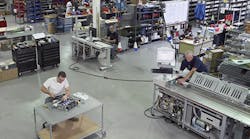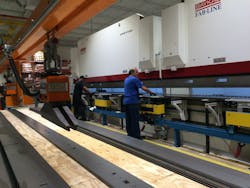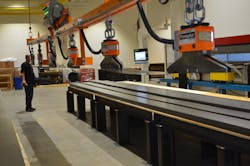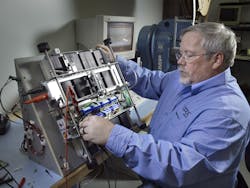For decades, American manufacturing prospered, spurred on by an insatiable desire for new products, continual improvements in technology and an abundant workforce of skilled manufacturing tradesmen. But as companies progressively moved their manufacturing overseas, so went the jobs for hundreds-of-thousands of skilled workers who either retired from the workforce or adapted themselves to different occupations.
Now, a growing number of companies are bringing their manufacturing back to the U.S., and many that retained their manufacturing operations here are expanding their facilities. The demand for skilled manufacturing workers across the country is on the rise, but that demand exceeds the supply of workers with the necessary skills.
According to the Manpower Group’s recent Talent Shortage Survey, which identified the top 10 most difficult jobs for employers to fill, number one on the list was skilled trade workers, such as computerized numerical control (CNC) machinists, welders and electricians. The same results have come up for the past five consecutive years.
For decades, U.S. manufacturers have relied on trade schools, community colleges and apprenticeship programs to train skilled tradesmen for manufacturing. But since the 1980s and 1990s with the offshore outsourcing of manufacturing, trade school and community college attendance for these positions has severely dropped, and most company apprenticeship programs have been diminished or eliminated.
Those companies that elected to keep their manufacturing in the U.S., however, still needed skilled manufacturing workers, and the most efficient and direct way to achieve this was through company-sponsored, structured training programs.
Training Skilled Tradesmen for Manufacturing
One company that stands out particularly, which early on developed and implemented in-house training programs for its skilled manufacturing employees, is OPEX Corp., headquartered in Moorestown, N.J. OPEX, a manufacturer of high-speed automated mailroom, document scanning and material handling systems, has been providing structured, company-sponsored training programs to develop skilled workers, continuously since the early 2000s.
Despite the trend to push manufacturing offshore for the last 30 years, OPEX made a deliberate choice in the other direction, and instead invested heavily into training its employees, while keeping its manufacturing operations squarely on U.S. soil. The company has been at the forefront of employing and training previously unskilled workers, and transforming them into highly skilled manufacturing tradesmen like CNC machinists and programmers, welders, electronic technicians and woodworkers.
The breadth of this company’s training programs is extensive, reaching well beyond manufacturing. OPEX maintains one of the most comprehensive service organizations in the industrial sector. Where outsourcing field technicians is the norm, OPEX built its own worldwide network of over 300 locally-based, direct-employee field technicians, which provide full 24/7/365 support to its thousands of customers. Every one of these technicians has been factory trained and certified at OPEX.
“The shortage of skilled manufacturing tradesmen has presented some unique challenges for us,” says Doug Hendry, manufacturing operations manager at OPEX, and first class journeyman machinist. “Like so many other manufacturers, when we put out ads for qualified CNC machinists, for example, we do not get very many applicants. The pool of skilled labor has disappeared, as manufacturing has gone offshore.
“To deal with this problem, we implemented comprehensive training programs,” continues Hendry. “We take entry-level workers and put them through a rigorous in-house, two-year, hands-on training program in manufacturing on our various machines. We turn them into skilled tradesmen that we can employ in our manufacturing facilities.”
OPEX recruits candidates for its training programs from several sources, such as from existing workers who express interest in becoming skilled in specific manufacturing trades. These workers could have absolutely no experience in skilled manufacturing, or may be proficient in some other occupation. Candidates are also recruited from local-area vocational schools, community colleges and high schools.
Additionally, the company has interned several students from the Yale School for handicapped students in Cherry Hill, N.J., over the last few years. The students have worked in OPEX’s assembly department, where they gained important job skills. The program has worked very well for both Yale School and OPEX. Students that are identified as high performers are frequently accepted into the OPEX in-house training program.
“Take our electronics shop, for example,” Hendry says. “When electronics technology students get to their junior year, they qualify to do internships at local manufacturers. We will recruit some of these students who demonstrate they have the aptitude to perform the work in our electronics shop, and supplement their education with hands-on training. We start them off with very simple testing tasks. Then we incrementally progress them up to testing and fixing circuit boards, configuring and repairing PCs, wiring machines on our assembly floor, and helping to troubleshoot system-level machines before they ship out. We have found this to be a great source of talent for hiring into our electronics department.”
When a new trainee is brought into the program, he or she is placed one-on-one with a skilled mentor. One task at a time, the trainee learns how to perform specific actions associated with the job. The trainee’s actions are supervised closely by the mentor until a high level of proficiency is achieved.
Focus on Metalworkers
Much of the OPEX product line requires sheet metal fabricating, so the company has focused more on metalworking trades with its training programs. For many years community colleges were not even offering metalworking programs, that is, until recently, where they are starting to become available again. But for quite some time, OPEX has been turning out many of its own skilled metalworkers and CNC operators.
Its CNC training program, for example, can turn out skilled CNC operators in two years, with individuals who have no prior machining background. Starting out with deburring and polishing, the trainee learns machining operations. He or she then learns basic mathematics, materials, tooling and machine set-up—skills that typically could take someone several years to achieve in a trade school or community college program. The OPEX trainee gains the certainty to operate as a capable machinist with the industry’s latest CNC equipment in the real-world environment.
“Within the past few years we have put 11 people through the metalworking program,” says Hendry. “To accept a candidate for training, the first thing we look for is someone who is reliable, and second, the person has to have a good work ethic. He or she has to be willing to learn, and must be team oriented. Few companies today invest in on-the-job training. We believe for a company to grow, it must rely on its workers, and they must be given the opportunity to grow.”
A Model for Streamlined Production
Sticking true to its goal of bringing back skilled manufacturing to the U.S., in January 2015 OPEX opened its newest manufacturing facility—a 42,000 sq. ft metal fabricating plant located in Pennsauken Township, N.J., a short distance across the Pennsylvania border from Philadelphia, and about 10 minutes down the road from OPEX’s flagship 250,000 sq. ft. manufacturing and corporate complex in neighboring Moorestown, N.J. Every aspect of the shop has been designed with the latest technology and processes for efficient operation. By any standard, this new metalworking shop is a model for streamlined production.
This latest shop is OPEX’s second fully-operational metalworking facility. This shop is focused on producing the company’s rapidly growing Perfect Pick material handling technology.
Shortly after opening the shop, the facility went into production operating two shifts per day, six days per week, producing the large storage racking modules for Perfect Pick.
Streamlined Metalworking Processes, from Raw Materials to Shipping
The shop’s process starts with cold-rolled steel raw material, and finishes with assembled units shipped. It is a full turnkey metalworking shop operation, encompassing coil punching, metal bending, welding, painting, assembly, testing and shipping.
Raw Material—The shop receives up to 10,000-pound coils of .090” cold-rolled steel, which comes in from the supplier already slit to the width and thickness required. The coils are maneuvered with a 7-1/2 ton overhead crane manufactured by Sissco Material Handling.
Coil Punching—The coil is fed into a Dalcos coil punching machine. The machine holds the required tolerances of +/- within 5,000ths of an inch over a 32-foot distance—the lengths of the finished sheets. The machine’s multiple hydraulic punching heads are capable of performing the required 700 perforations per part in just over three minutes, which is highly efficient. This is accomplished by a technological combination of hydraulically operated punches and precise positioning by means of ball screws. The machine may be set up with one or more moving punch heads, aligned or opposed according to requirements, to allow simultaneous front and back machining of symmetrical products.
The punched sheets are cut to 32-foot lengths, then discharged onto a roller conveyor where they are moved to an accumulation area and banked for the next process, which is the press brake.
The Dalcos punch is equipped with a physical four-foot fencing system surrounding it, for safety, and proximity laser scanning which recognizes persons and objects inside a defined protection field. The punch will shut down when these perimeters are transgressed.
Press Brake—The shop installed a 40-foot, 660-ton tandem press brake, manufactured by Baykal Machine Tools. Twin 20-foot press brakes are mated together at the center to form the singular CNC-synchronized machine. Like the coil punching, the press brake is also holding very close tolerances over the length of the 32-foot sheets.
OPEX's 40 foot, 660-ton tandem press brake.
Two synchronized, one-quarter-ton, permanent magnetic overhead cranes, manufactured by Permadur Industries, maneuver the flat sheet stock off of the accumulation area rollers, and move it to a staging area for the press brake. When ready for induction onto the machine, the magnetic cranes lift up the punched-steel sheet and maneuver it into the press.
These electrically-controlled, permanent magnet cranes are made to maneuver ferromagnetic materials of varying shapes and sizes. They allow for incredible lifting capacity and portability. The cranes are remotely controlled, so no workers handle the sheet metal. The magnets do the lifting work safely and efficiently. They will not drop a suspended load due to power failure or faulty wiring. No back-up battery system is required.
Synchronized one-quarter-ton magnetic overhead cranes.
When the press brake work is complete, the magnetic cranes lift the sheet from the machine, placing it onto output accumulation area rollers. The accumulated sheets are then discharged onto a roller conveyor where they are moved to the next process, welding.
Welding/Painting/Assembly/Testing/Shipping—After welding, the partially-assembled Perfect Pick frame is lifted onto custom-made roller dollies, which allow for safe transport throughout the rest of the process. The frame is rolled into the final processes of painting, assembly, testing, and finally shipping. Lastly, a remote-controlled overhead up-ender crane rotates the frame 90 degrees, and places it on a heavy-duty shipping skid with casters that function as a dolly.
Ergonomics—Every process in this new metalworking plant was designed with improved ergonomics in mind. A primary objective was to reduce potential hazards for workers.
“The height of the machines and parts staging areas, the conveyor systems that carry the parts to loading areas, these were all designed at a user-friendly height,” says Hendry. “Utilizing overhead cranes throughout the facility provides a major ergonomic and safety benefit to our workers. The cranes also provide a significant reduction in the number of personnel required to execute those tasks. From welding through shipping, our machines are wheeled through the final processes, with little strain on our workers.”
In the assembly area, the Perfect Pick robotic delivery vehicles, called iBOTs, which weigh approximately 60 pounds and contain considerable electronics, are built on custom-designed frames which permit the iBOTs to be easily rotated 360 degrees while being assembled. This too, makes for a much more comfortable assembly process for the OPEX electronics technicians.
OPEX technician assembling an iBOT robotic vehicle.
“For the most part, the work is brought to our workers,” continues Hendry. “From a safety standpoint, no one is bending over throughout our entire metalworking manufacturing processes.”
Energy Efficiency
The new plant was designed with multiple energy-efficient and sustainable systems. OPEX has a strong track record of implementing such initiatives into its manufacturing operations. Just a few years ago the company installed a 2.77 megawatt solar array system, capable of producing more than 100% of the electrical energy needed to operate its total manufacturing, distribution and administrative complex in Moorestown, N.J. This effectively made OPEX a net-zero user of electrical power from traditional energy sources. Its conversion to sun power made it the largest solar installation in the state of New Jersey operated by a privately-held company, at the time of its installation. In effect, power required to manufacture the company’s entire product line is now derived 100% from a sustainable source.
Because of the energy-saving and sustainable systems designed into this new metalworking facility, the total energy usage of the company still is less than what is generated through its solar array system, making this new plant as well a net-zero user of electrical power from traditional energy sources.
Contributing to this is the outfitting of the entire interior work area, as well as the exterior grounds of the plant, with low-voltage LED lighting. Few manufacturing plants in the U.S. have achieved 100% LED lighting. This lighting uses 72% less energy than conventional plant lighting, and operates for 80,000 hours. Also supporting energy reduction was the installation of multiple high-efficiency rooftop heating and air conditioning units. Because of these initiatives, and other energy-saving factors, the total energy usage is approximately $3.40 per hour to run the entire 42,000 sq. ft. plant.
On the Comeback Trail
With the many design, production, ergonomic and sustainable systems built into this facility, this new metalworking shop presents a model for more efficient manufacturing. It also overtly makes the statement that manufacturing in the U.S. is on the comeback.
While many companies have outsourced their manufacturing operations overseas, a growing number have opted to not only retain, but expand their skilled manufacturing facilities within the United States.
“There are a number of reasons why OPEX has continued to manufacture its products in the U.S., instead of outsourcing overseas,” says Dave Andrews, facilities manager at OPEX. “We wanted to have better control over our quality, better responsiveness to our customers, more flexibility with implementing engineering changes, and reduce the cycle time for the introduction of new products.
“But underneath all of these, it is simply the commitment to American manufacturing, and the skilled jobs that this brings,” adds Andrews. “If more companies shared this vision it would go a long way to building a stronger America.”
Jim McMahon writes on advances in manufacturing.







